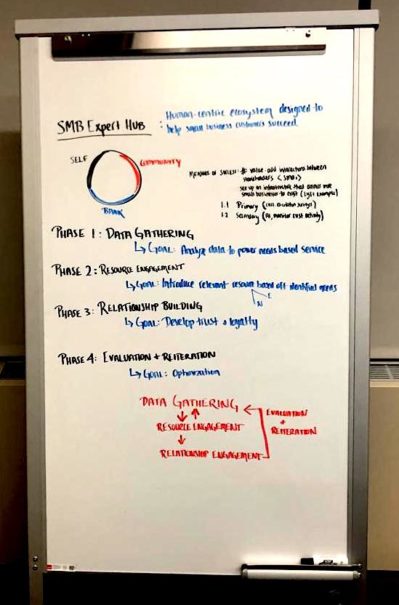
It’s the age of the customer, and major corporations are taking note. Never before has there been more access to information and less tolerance for missteps in the customer experience. That is why a multinational financial services company approached the Mack Institute’s Collaborative Innovation Program (CIP) in 2018 with a question: What does the ideal service model look like for small business banking customers?
To approach this issue, my CIP team needed to search for answers beyond industry best practice. Delivering truly innovative solutions required investigation of questions such as:
- What is the optimal balance of technology and human touch?
- How can we create a personalized customer experience while maintaining scale and efficiency?
- How can we simultaneously solve for today’s challenges and challenges that will arise 10 years from now?
Tapping into our team’s diverse experience ranging from design and fintech to behavioral science, we developed a human-centric customer service hub encompassing digital, community, and autonomous interactions. The design leveraged technology to personalize experiences and offerings, while fostering real-world connections in an industry where this has been increasingly devalued.
The Value of CIP
In work and education alike, we so often get caught up in the tactical, focusing on how we can complete a deadline or assignment as efficiently as possible. CIP provides a unique opportunity to take a step back and consider the big picture. Well-respected companies with complex challenges come to the Mack Institute for original ideas, and the lack of rigid guidelines presents the opportunity to take risks, think unconventionally, and present bold recommendations.

The experience I gained from the Collaborative Innovation Program was immensely valuable in equipping me with the tools needed to drive innovation. A few major lessons emerged that will empower me throughout my career:
- Think in fantasy, execute in reality. Unconventional ideas are encouraged when developing innovative solutions, but there must be data, theory, and insight to back up why such a strategy will succeed. CIP allows the opportunity to take risks that may otherwise not be taken in a typical work environment, and provides the tools necessary to support risky thinking with research.
- Innovation does not mean complexity. A truly innovative solution should be complex in its motivation and simple in its delivery. Our project sponsor stressed the importance of this skill by challenging our team to create an executive view of our final deliverable, allowing no more than five minutes for explanation. The Mack Institute staff was invaluable in their guidance, particularly in this regard.
- Engagement with a variety of individuals is critical. Consider perspectives that are different from yours. Throughout our project, I had the opportunity to interview numerous small business owners ranging from florists to accountants, as well as professors, former colleagues, and classmates. Innovation meant something different to each of them. Learning how to ask the right questions, reflect on responses, and identify common themes was the most enjoyable aspect of the project for me.
The Collaborative Innovation Program allowed full immersion into the innovation process, an experience that can’t be matched in a typical classroom environment. I highly recommend this experience to anyone interested in a firsthand look at how innovation happens — a process typically limited to a select few.
Sign up here for email notifications about CIP recruitment. Read about more students’ CIP experiences here.
About the Author
Lauren Gaudreau is currently pursuing a Master of Behavioral and Decision Sciences at the College of Liberal and Professional Studies from the University of Pennsylvania. Prior to graduate school, Lauren worked in KPMG’s advisory practice in the deal and strategy groups, as well BounceX, a New York-based SaaS company. She is currently spending the summer as a behavioral researcher with the Duke-affiliated Center for Advanced Hindsight.



